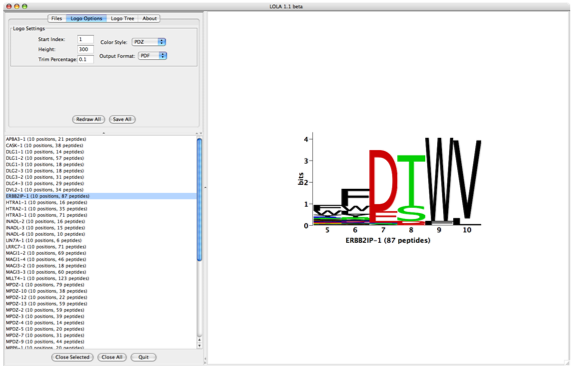LOLA (LOgos Look Amazing) is a tool for generating sequence logos using Position Weight Matrix based protein profiles. LOLA allows you to generate custom sequence logos by setting parameters such as logo height, trim percentage, and residue colour scheme. You can then save logos in various formats including PDF, PNG, and JPEG.
LOLA is currently in beta-testing. Version 1.36 is now available for download.
Downloads
Latest Release
LOLA Version 1.36 (April 4, 2012) Build (verified to run with jre 1.6.0_22): LOLA-1.36.zip
Current Development Release
LOLA Version 1.36 (April 4, 2012) Source + dependencies (verified to run with jre 1.6.0_22): LOLA-1.36-src.zip
Earlier Stable Releases
LOLA Version 1.35 Alpha (June 5, 2009)
Build: LOLA-1.35-alpha.zip (verified to run with jre 1.6.0_22)
LOLA Version 1.3 Beta (September 29, 2008)
Build: LOLA-1.3-beta.tgz
Source: LOLA-1.3-beta-src.tgz
LOLA Version 1.2 Beta (May 12, 2008)
Build: LOLA-1.2-beta.tgz
Source: LOLA-1.2-beta-src.tgz
LOLA Version 1.1 Beta (August 22, 2007)
Build: LOLA-1.1-beta.tgz
Source: LOLA-1.1-beta-src.tgz
Release Notes
Version 1.36:
- Position weight matrices in PWM file format can now be loaded (please see file formats below).
Users can choose to draw logos with or without axis labels via Logo Options -> Basic.
Version 1.35 alpha:
- Java Runtime Environment (JRE) 1.6 is required to run LOLA (verified to run with jre 1.6.0_22). All other dependencies are included in the download.
- For each occurrence of the symbol 'X' (which represents an ambiguous amino acid) at a position in the profile, contribute an equal 1/20 weight to each residue in the corresponding weight distribution. Previously, the weight contributed to each residue was 1.0, causing inflation of "background" signal and hence suppression of significant features at the given position.
Version 1.3 beta:
- Progress bars now appear for long-running tasks such as loading peptide file and generating logos and logo trees
- Notable bug fixes:
- Selected profiles now correctly closed with the "Close Selected" button.
- Regenerating a logo tree after closing some profiles now correctly excludes the closed profiles.
Version 1.2 beta:
- Logo trees can be generated for all types of domains - not only terminal binding
- New advanced options including amino acid coloring styles, amino acid grouping, and logo tree leaf ordering
Version 1.1 beta:
New Logo Tree feature - basic functionality for PDZ or other terminal binding motifs not requiring profile alignment
Installing and Running
Requirements: Java Runtime Environment (JRE) 1.5 or later is required to run LOLA. All other dependencies are included in the download.
- Extract the TAR file. This will create a directory named "lola".
- On Linux, open the command shell and run "lola.sh" from the "lola" directory.
- On Windows, double click "lola.bat".
- On Mac, double click lola-1.0-beta.jar
LOLA accepts one or more peptide files as shown in the example below. A peptide file describes a protein containing a specific domain, and provides known peptide ligands of this domain obtained by an experimental technique. You can open a single peptide file, or multiple peptide files grouped into a project file.
LOLA also accepts one or more pwm files as shown in the example below. A pwm file describes a position weight matrix (rows are amino acids, columns are ligand positions) where each cell in the matrix represents the frequency of observing a specific amino acid at a given ligand position. You can open a single pwm file, or multiple pwm files grouped into a project file.
Here's a view of LOLA after opening a PDZ domain project file, and after generating a logo tree:
Changing memory allocations on Windows, Mac, and Linux machines
There are a number of ways to change LOLA's memory allocation, depending on your preferred method of opening the application.
Option A: Command line startup (note: this does not permanently change LOLA's default 512M setting)
If you are opening LOLA from the command-line using the command:
- java –Xmx512M –jar lola-VERSION.jar
then you can increase the value of –Xmx to the desired amount of memory. For example:
- java –Xmx800M –jar lola-VERSION.jar
Option B: Using lola.bat (Windows systems)
- Open the file lola.bat in a text editor (eg. right-click and select Open With Notepad).
- Increase the value of the –Xmx tag (found in the last line of the file), as per Option A. Do not modify other parts of the file.
- Save and close the file.
- Open LOLA by double-clicking on lola.bat.
Option C: Using lola.sh (UNIX, Linux, and Mac OS X systems)
Open the file lola.sh in a text editor (eg. right-click and select Open With TextEdit).
- Increase the value of the –Xmx tag (found in the last line of the file), as per Option A. Do not modify other parts of the file.
- Save and close the file.
- Open LOLA by running lola.sh from the command-line.
References
LOLA has been referenced in the following publications:
Tonikian, R.
et al.(2008) A Specificity Map for the PDZ Domain Family.
PLOS Biology, 6, 9: 2043-2059.
http://biology.plosjournals.org/perlserv/?request=get-document&doi=10.1371/journal.pbio.0060239
Future Developments
- Enable logo and logo tree parameters to be saved in a project file for later use
- Support customized amino acid grouping schemes
- Allow colours to be selected for individual amino-acids
- Add support for nucleic acids
- Additional visualization options (e.g. font, axis labels)
Contact
If you have any questions or feedback, please email Moyez Dharsee at mdharsee@infochromics.com .

